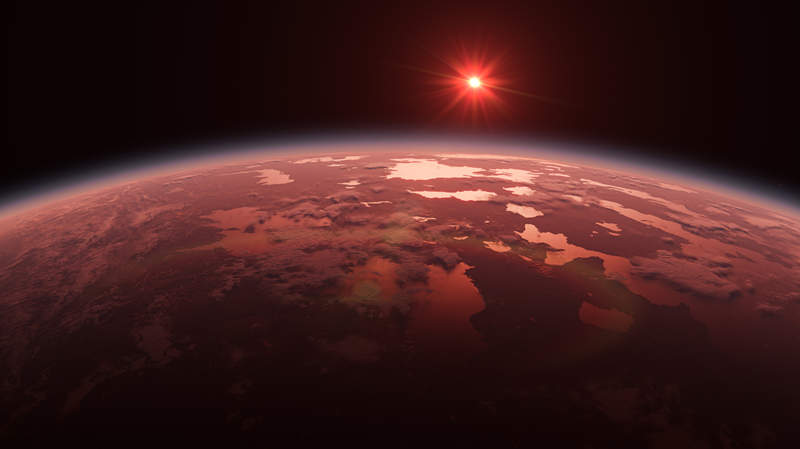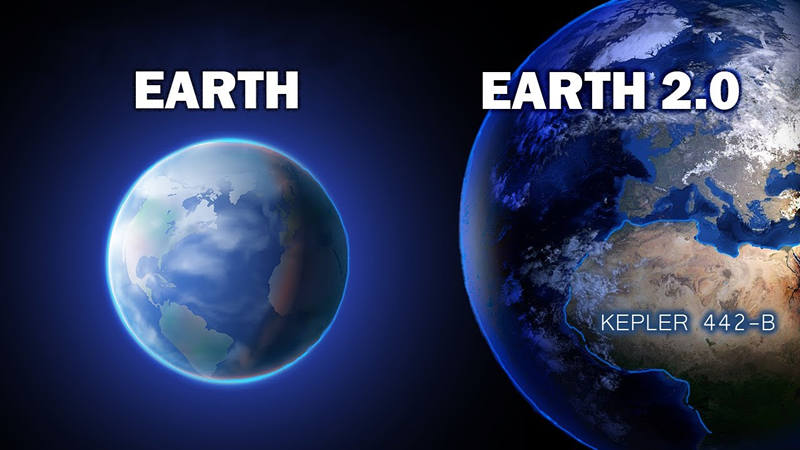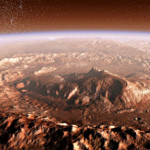Since the beginning of our exploration of the cosmos, humanity has been searching for a planet similar to ours. This involves not only its characteristics but also its position relative to its star so that it can be within the habitable zone. Up until today, the exoplanet Kepler-442b is, as far as we know on Earth, the only celestial body possessing the necessary features capable of sustaining life. In this article, we will introduce you to the unique features of the exoplanet Kepler-442b and its significance to us.
1. Discovery Process
Kepler-442b was discovered as part of an observation mission initiated by NASA’s Kepler Space Telescope in 2009. This mission primarily aimed to search for possible planetary transits by observing changes in the brightness of stars. After observing 50,000 stars from the Kepler input catalog, scientists detected periodic variations in the brightness of the star Kepler-442, occurring every 113 days. This led scientists to conclude that there must be a planetary body causing these periodic transit phenomena. This discovery, along with the unique planetary systems of Kepler-438 and Kepler-440 stars, was announced on January 6, 2015.

2. Subsequent Research
While the discovery of Kepler-442b generated significant interest among scientists, its distance of approximately 370 parsecs (1,200 light-years) makes it too distant, and its star too remote, for current telescopes or the next-generation planned telescopes to determine its mass or the presence of an atmosphere. However, upcoming planet-hunting space telescopes like TESS and CHEOPS will examine nearby stars in the sky. The James Webb Space Telescope and future large ground-based telescopes can study stars with planets nearby, analyze atmospheres, determine masses, and infer compositions. Additionally, square kilometer array telescopes will significantly improve radio observations at observatories like Arecibo and Green Bank. Despite being described as an Earth-like exoplanet, scientists still require further research to determine its habitability and Earth-likeness. Future research may involve more detailed observations and analysis of Kepler-442b using advanced telescopes and detectors, as well as the detection and study of other planets in the Kepler-442 system to further understand the quantity, distribution, and characteristics of planets in this system.
3. Mass, Radius, and Temperature
Kepler-442b is a super-Earth with an estimated mass of 2.34 Earth masses and a radius 1.34 times that of Earth. Both the mass and radius of this exoplanet are larger than Earth but smaller than the ice giants Uranus and Neptune. Due to its radius, it may be a rocky planet with a solid surface. Assuming a composition similar to Earth, the surface gravity on Kepler-442b would be approximately 30% stronger than that on Earth. This means that a person weighing around 80 kilograms on Earth would weigh slightly over 100 kilograms on the surface of Kepler-442b. According to the Planetary Habitability Laboratory’s temperature classification, if Kepler-442b has an atmosphere similar to Earth’s, its surface temperature would be approximately -2.65°C, making it a cold planet. Its equilibrium temperature is 233 K (-40°C; -40°F). It receives a similar amount of sunlight as Earth, which could allow water to exist on its surface in a form similar to that on Earth.

4. Orbit
Kepler-442b has an orbital radius smaller than Earth, at 0.41 astronomical units, with an orbital period of 112 days. According to its discoverers, Kepler-442b has a 96.9% probability of being within the habitable zone of its star. Its orbital radius is approximately 0.4 AU (60 million kilometers; 37 million miles), slightly larger than the distance of Mercury from the Sun, which is about 0.38 AU (57 million kilometers; 35 million miles). It receives about 70% of the sunlight that Earth does. Kepler-442b is located approximately 1,115 light-years away from Earth (342 parsecs).
5. Rocky Exoplanets – Terrestrial Planets
Currently, only a small number of known rocky exoplanets are considered potentially habitable. Nevertheless, research indicates that none of these exoplanets meet the theoretical conditions for maintaining a terrestrial biosphere through “oxygen-producing” photosynthesis, a mechanism used by Earth’s plants to convert light and carbon dioxide into oxygen and nutrients.
Among these planets, only one orbits close enough to its host star to receive the necessary radiation to support a large biosphere: Kepler-442b. It’s a rocky exoplanet about twice the mass of Earth, moderately orbiting a star approximately 1,200 light-years away in the Cygnus constellation.
This study is based on a very small sample of such planets. However, astronomers know enough about the characteristics of stars in our Milky Way galaxy to infer that conditions suitable for life powered by photosynthesis may be relatively rare. Most stars in the Milky Way are classified as red dwarfs, which are too cool to drive photosynthesis activity on nearby planets.
“So far, red dwarfs are the most common type of stars in our Milky Way. This result implies that Earth-like conditions on other planets may be much less common than we might expect,” said Professor Giovanni Covone, the first author of the study. For instance, among the 30 stars closest to the Sun, 20 are considered red dwarfs.

6. Exoplanetary Research
Research on exoplanets suggests that stars hotter than our Sun are also unsuitable for hosting Earth-like conditions. Bright stars tend to burn out quickly. While they can produce enough photosynthetically active radiation (PAR) to trigger such activity on planets with water and carbon, they may go extinct before complex life evolves on them.
“This study imposes strong constraints on the parameter space for complex life. Unfortunately, the ‘best places’ for a rich land biosphere may not be so wide,” added Covone.
Astronomers have discovered thousands of exoplanets within our Milky Way galaxy, but our knowledge about them is relatively limited. Nevertheless, scientists suggest that finding rocky planets similar to Earth within the habitable zone where water could exist seems uncommon.
Future missions, such as the James Webb Space Telescope (JWST) scheduled for launch later this year, may reveal more about distant worlds around other stars and the potential for complex life on them.
7. Physical Characteristics of Kepler-442b
Kepler-442b is a super-Earth, a rocky exoplanet with a mass and radius greater than Earth but smaller than ice giants like Uranus and Neptune. Its equilibrium temperature is 233 K (-40°C). Given its radius, it’s likely a rocky planet with a solid surface. The estimated mass of this exoplanet is 2.36 times that of Earth. Assuming a composition similar to Earth’s, Kepler-442b’s surface gravity would be approximately 30% stronger than Earth’s.
The host star of Kepler-442b has a mass of 0.61 times that of our Sun, a radius of 0.60 times that of our Sun, a temperature of 4402 K, and an age of approximately 2.9 billion years, with some uncertainty. In comparison, the Sun has a history of about 4.6 billion years, a temperature of 5778 K, and a metallicity (Fe/H) of -0.37, 43% of solar metallicity, slightly lower in metal content. Its luminosity is 12% that of the Sun. The star’s visual magnitude, or brightness as seen from Earth, is 14.76, making it too faint to be visible to the naked eye.

8. The Uniqueness of Kepler-442b
Known potentially habitable exoplanets, resembling Earth, lack the suitable conditions to sustain life as we know it on our planet. Earth boasts a rich ecosystem of plants, microorganisms, and animals. However, there is only one exoplanet, Kepler-442b, that comes close to receiving the necessary stellar radiation to maintain a large biosphere.
A study published in the Monthly Notices of the Royal Astronomical Society assessed the fundamental conditions required for oxygen-based photosynthesis. This investigation covered ten known Earth-like exoplanets with masses that orbit within what is known as the habitable zone around their respective stars.
The habitable zone is the region around a star where temperatures are conducive to the existence of liquid water, a critical prerequisite for life as we know it on Earth. However, the research by astronomers at the University of Naples in Italy revealed that being within the habitable zone alone is not sufficient.
Photosynthesis is essential, as it enables the development of complex ecosystems similar to those found on Earth. To facilitate this crucial process, where plants and certain microorganisms convert light into organic matter, a certain amount of sunlight is required. This process also results in the production of oxygen as a byproduct. Not all stars are capable of providing the necessary conditions for photosynthesis, creating a distinction between exoplanets and Earth. Within our own Milky Way galaxy, thousands of exoplanets have been confirmed. Nevertheless, research indicates that Earth-like and habitable-zone exoplanets are relatively rare.
END:
In summary, “Kepler-442b” is a potentially habitable exoplanet similar to Earth. It has a longer “lifespan” for its host star compared to the Sun, and the habitable zone on its surface is likely broader than that of Earth. For these reasons, it is considered a planet with conditions that may even surpass those of Earth. So, is it feasible for humanity to migrate to this “super-Earth” in the future?
Observational data indicates that “Kepler-442b” is approximately 1,200 light-years away from us. It is evident that with our current level of technology, bridging such a vast distance is currently impractical. However, we should not lose hope. After all, human aspirations reach for the stars and beyond. In the long term, as technology continues to advance, the idea of humans conquering the 1,200-light-year distance is not entirely implausible.
More UFOs and mysterious files, please check out our YouTube channel: MysFiles
Is the moon artificial? Evidence Proves the Moon Was Unnaturally Formed








